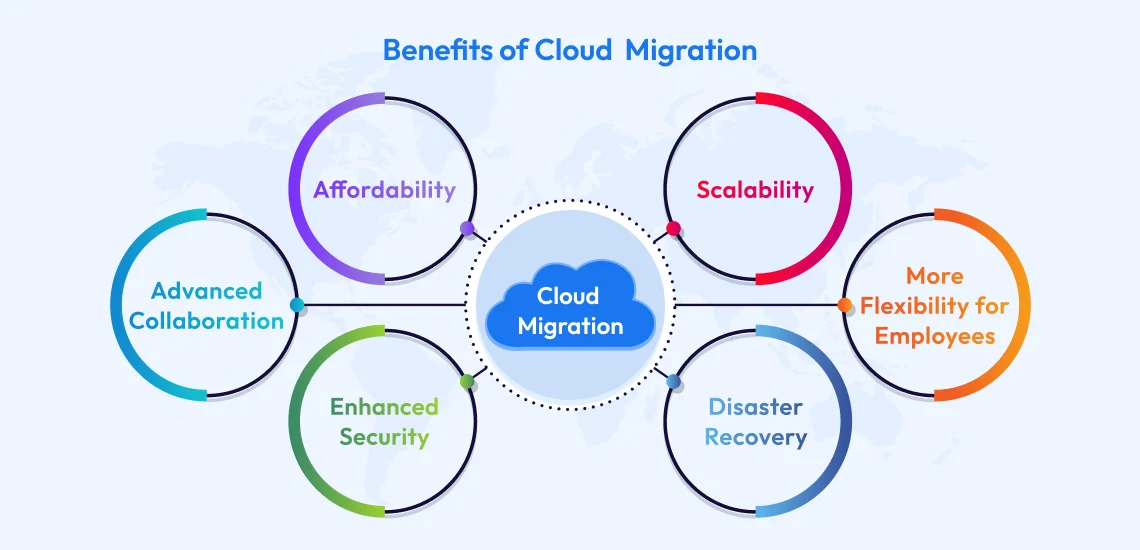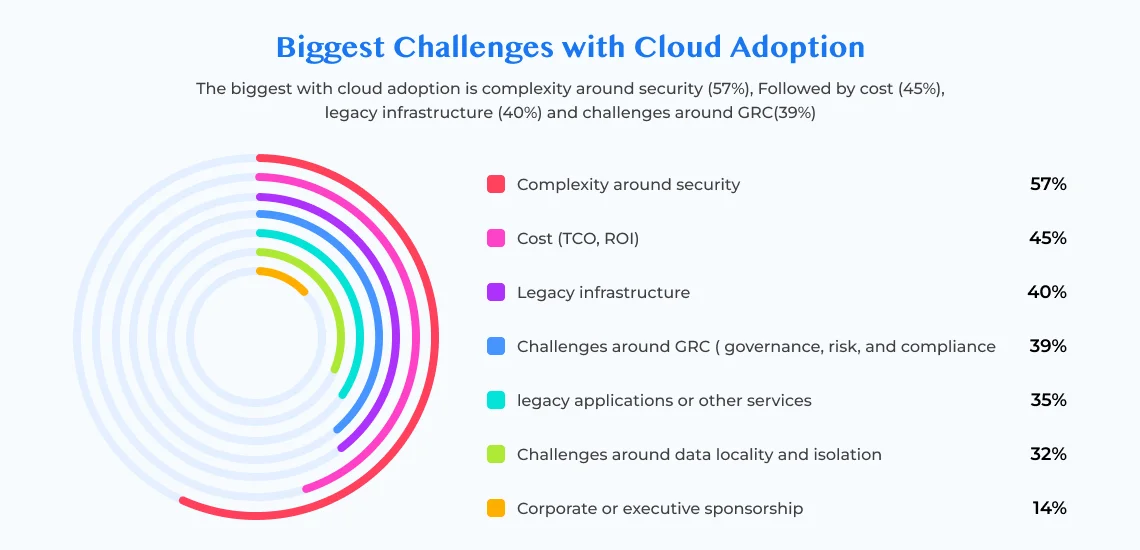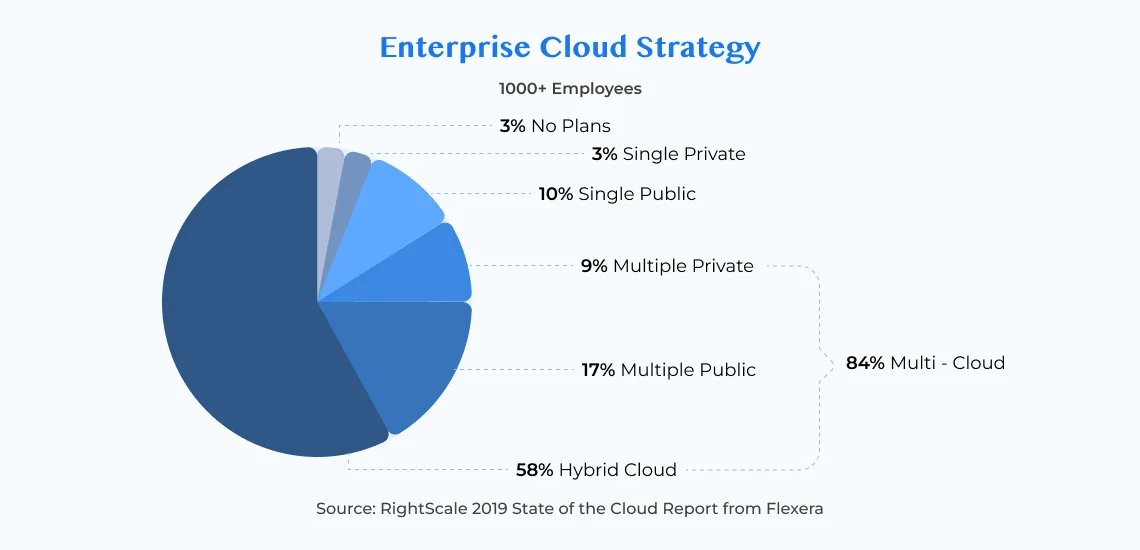Cloud Migration – Benefits, Challenges, and How to Avoid Them
- DevOps
- December 4, 2023
Cloud computing has emerged as a key technology trend for businesses looking to modernize their IT infrastructure, improve operational efficiency, and drive business growth. In this blog post, you will get insights into cloud migration, the benefits of cloud migration, challenges, and solutions to those challenges.
Recent times have seen many enterprises opting for cloud migration owing to various benefits, whether it is JP Morgan, Netflix, Spotify, Airbnb, or any other organization, regardless of size.
According to cloud computing statistics, 73% of enterprises have deployed a hybrid cloud in their organizations as of 2024. This highlights the significance of cloud migration and utilizing public, hybrid, or private clouds to host data or run enterprise applications.
With every passing year, more and more organizations are adopting these solutions. Cloud solutions are becoming a cornerstone of modern business operations, driving efficiency and innovation.
The future of cloud computing is shaping industries by offering scalable, flexible, and cost-effective technologies. As these advancements continue to evolve, they are proving to be commercially successful and indispensable for modern enterprises.
However, concerns about reliability and security still cause some organizations to delay their cloud migration, fearing it may not be beneficial. Despite these concerns, the global shift towards cloud technologies is undeniable, and they are increasingly becoming a necessity.
Let’s explore what it is, why enterprises and businesses should migrate to the cloud, the challenges your enterprise may face in cloud migration, and how to avoid potential challenges.
What is Cloud Migration?
Cloud migration is the process of moving applications, data, or even the whole enterprise IT infrastructure from on-premises or co-located servers to a cloud-based environment. This cloud environment can be public, private, or hybrid. Various cloud services are available that organizations can choose from based on their business requirements, scalability needs, security requirements, service offerings, and more.
Regardless of the cloud services organizations choose, they are designed to handle any workload and facilitate the rapid inclusion of new services, allowing businesses to quickly respond to changing needs.
Let’s explore the benefits that cloud solutions can offer your business.
Key Benefits of Cloud Migration

The decision to transition to cloud computing comes with a multitude of benefits. Here are some benefits of migrating to the cloud:
1. Affordability
Migrating to cloud is a cost-effective for organizations. Companies can save a lot by cloud migration, particularly in the long run. In comparison with on-premise hardware, you have no upfront investment with the cloud.
Also, the energy expenses for keeping the systems up become affordable. Moreover, you don’t need to pay somebody for maintaining your hardware, because your cloud provider does everything. You just pay for what you utilize and nothing more than that.
2. Scalability
You might experience capacity issues while using on-premise infrastructure. However, adopting cloud migration can help you eliminate these capacity problems entirely. Migrating to the cloud provides businesses with on-demand capacity utilization and a pay-as-you-go model. This ensures that no seasonality or development will threaten to upend your operations.
Previously, businesses used to encounter traffic levels that their present infrastructure could not manage; hence, they had to purchase a new server only. And these servers are not at all cost-effective. However, using the cloud, businesses now can modify the storage, level of computing power, and bandwidth required at any time.
3. Enhanced Security
Enhanced security is one of the benefits of cloud migration. Cloud service providers make sure to maintain the most precise security measures for their clients. From authentic digital protections to high-end physical ones, they prioritize cybersecurity first.
The data centers and some top cloud providers globally safeguard your data. They can employ the brightest and best cybersecurity professionals available. This helps them increase their knowledge of enhancing their security practices continuously and offers a secure space for their client data.
4. More Flexibility for Employees
Cloud Migration helps you allure and retain your staff members, providing them improved flexibility. Many employees want the capacity for traveling and working remotely instead of working from 9 to 5 in the office space. And guess what, they can do that with cloud technology.
As long as your staff members have an active internet connection and a device, they can work using the capacity for enhanced collaboration offered by the cloud. This is freedom for the employees.
5. Advanced Collaboration
Collaboration means competitiveness and efficiency these days. Companies can embrace a lot of technologies for increasing their collaboration, and migrating to cloud is one of such technologies. Since everything is available through the internet, staff members can work together in various states, cities, or nations.
Employees can access files and documents on the cloud at the same time and update them in real-time. This collaboration helps boost proficiency. By leveraging cloud technology, you can focus on collaboration more easily for your staff to work together and create better concepts and solutions quicker than before.
6. Disaster Recovery
After migrating to cloud, businesses can back up their data. Some experts say that cloud backups are more secure than internal backups. Using cloud-based backups, you can store your data safely in high-end data centers run by the tech giants globally. These companies have several teams working 24×7 for securing your data.
When your data is secure, you won’t experience data loss. In case your system gets destroyed due to a natural disaster, a cloud-based backup will assist in your disaster recovery.
Although migrating to the cloud has several advantages, not every business accepts it. Like everything else, the cloud is also imperfect. You should ponder other things also before upgrading your company’s present operation mode and moving them to cloud technology. Now, let’s shed some light on the challenges involved in cloud migration!
Common Cloud Migration Challenges and Solutions
Cloud migration is a complex task that, when not done with careful and strategic planning, can present various challenges. Here are some of the common challenges faced during cloud migration and effective solutions that can streamline the migration process and maximize the benefits of cloud migration.
1. Incompatibility of the Current Architecture
Numerous organizations encounter a significant challenge during cloud migration due to the complexity of their existing IT architecture. This complexity often slows down the migration process, as organizations must locate individuals with the requisite IT skills to optimize their architecture for the cloud at the necessary pace.
Solution:
To make the architecture ready for cloud migration, you need to hire a team of IT experts that will fix tech debt, review the legacy architecture, make comprehensive documentation, and measure interdependent parts.
In case you want to mix private and public clouds with on-premise assets for making a hybrid environment, you should re-design your in-house IT infrastructure for reducing interoperability issues and inconsistencies among several systems.
2. Extra Latency
Extra latency is often an underestimated challenge in cloud migration. It arises when accessing databases, applications, and services in the cloud. For applications requiring instant responses, even brief delays can result in significant damage to your business. Beyond causing disappointment and frustration, it can also impact your brand reputation.
Solution:
To get rid of latency problems, you should first understand its causes: misconfigured QoS (Quality of Service) and the geographical distance between servers and client devices. Many ways are there to solve latency problems:
- Divide traffic flows
- Optimize and localize the network
- Offload the internet at the end
- Build multi-cloud connectivity
- Connect with ecosystems and business partners for online business or data exchanges.
In case the aforesaid cloud migration strategies are costly for you or do not help, ponder keeping such apps on-premise.
3. Complexity Around Cloud Migration Security
According to study, the complexity around security is the major cloud migration challenge that most companies (57%) face followed by pricing and legacy infrastructure.
Transferring data to the cloud brings many security challanges, such as insider threats, accidental errors, external attacks, malware, misconfigured servers, problems on the side of the cloud provider, insecure APIs, contractual violations, compliance breaches, etc.

A few companies already know these cloud migration risks and take some precautions for avoiding them. However, many still struggle to address these issues, leading to difficulties in fixing cloud migration security problems due to a lack of expertise.
As per report, 92% of respondents say they should improve cloud security skills, whereas 84% confirmed they require adding employees for bridging the gap. Just 27% of respondents had confidence in their capacity of identifying every cloud security alert.
Solution:
Leading cloud service providers like AWS and Azure offer security. They make sure to protect your physical assets from unauthorized access this makes cloud migration very secure. Maximum cloud vendors have a great portfolio of compliance services incorporating FIPS, CJIS, HIPAA, DISA, ITAR, etc. They spend much on security for safeguarding client data from cyber threats.
Moreover, they provide exclusive solutions to keep your client data secure while migrating to the cloud. Nevertheless, you should hire an experienced security team and some trained DevOps engineers who can make the required configurations and give assurance about the long-term data security in the cloud:
- Allow multi-factor authentication
- Encrypt data assets in migration and at rest
- Establish user access policies
- Configure a firewall
- Train others on the ways of maintaining security in the cloud
- Execute required controls
- Set individual workloads apart for reducing every damage that could happen because of an attacker
4. Inadequacy of Visibility and Control
Visibility in the public cloud poses a significant challenge when migrating to the cloud, affecting network and application functionality.
In case you depend on your on-premise data centers, take complete control over your resources, including data centers, networks, and physical hosts. However, when migrating to a cloud service provider through cloud migration, the responsibility for certain policies shifts to the cloud service provider based on the service type. As a result, the organization needs visibility into public cloud workloads.
As per a current survey by Dimensional Research, 95% of responding companies say visibility issues have caused network or app performance problems. And as per 38% of respondents, inadequate visibility is the main factor in app outages, while 31% claim it in network outages.
Solution:
Now several tools can help you in the app and network performance monitoring. Third-party security vendors and cloud service providers provide many solutions for that. Here are a few demands for efficient monitoring tools:
- Automatic response to some kinds of threats and alerts
- A steep learning curve
- Scopes for configuring various types of alerts
- Strong analytics
- A monitoring solution must integrate simply with other solutions
- Fundamental monitoring capacities with no requirement for manual configuration
5. Wasted Cloud Costs
Cloud providers’ pricing models are flexible; however, sometimes hard to understand particularly in case you are a newbie in this field. According to the estimation of Gartner analysts Craig Lowery and Brandon Medford, as much as 70% of cloud costs get wasted.
You need to pay for computers, data transfer and storage in cloud computing. And every cloud vendor provides several storage services, instance types, and transfer choices based on your price needs, use case, and performance expectations.
Finding the right one can be difficult. Organizations that fail to find out what they require generally waste their prices because they don’t utilize the chances they get.
Solution:
You should optimize your cloud costs. In case you are unaware of doing it, hire experts to help you. Some common cloud cost optimization practices are as follows:
- Use discounts
- Erase underused instances
- Increase spot instances for serverless and stuff that do not need high availability
- Administer your workloads
- Spend on reserved instances
- Take benefit of autoscaling
- Check whether hosting in another region could lower costs
- Fix alerts to cross pre-decided spend thresholds
- Shift irregularly accessed storage to more inexpensive tiers
6. Lack of a Comprehensive Cloud Migration Strategy
It’s crucial to determine whether to opt for a single cloud provider or engage with multiple cloud platforms during the cloud migration process. Each approach has its pros and cons. While choosing a single cloud provider may lead to vendor lock-in challenges, working with multiple providers allows for workload balancing across different platforms.
However, it is costlier and more complex as every provider offers various tools and services for cloud management, but it provides freedom also. As per McAfee’s Cloud Adoption and Risk Report, 78% of companies are presently utilizing both Azure and AWS for avoiding basic challenges in cloud migration.
Moreover, you need to determine what you will migrate to the cloud and what you will leave on the on-premise data centers. In case you choose a hybrid technique, plan according to that. Not all parts of your infrastructure are perfect for migration. Don’t keep client’s data, financial records in the public cloud.

In case you have sensitive data, store them on the on-premise data centers, and utilize a public cloud platform for flexibility, compute strength, scalability, and connectivity.
Solution:
Don’t get hyped and rush into shifting your workloads quickly to a cloud platform, even if somebody recommends it. What is beneficial for one organization can become destructive for your business. Without proper planning and a rock-solid cloud migration strategy, you may end up with system failures and huge expenses.
7. Data Loss
Before migrating to the cloud, ensure to back up all your data, particularly the files that you will move. During the cloud data migration procedure, you may experience some problems like missing, incomplete, or corrupted files. And in case you have backed up all your data, you can easily rectify the errors by restoring the data to its previous condition.
Solution:
Anything from a security violation to a power outage at a data center may lead to data loss. So, if you store the backups of databases in the cloud or on a server, you can restore all the data fast.
Moreover, in case you utilize many cloud providers, you don’t have to be worried regarding the sudden failure of the service of a specific provider. You always can distribute an independent replica of your app on the infrastructure of another provider.
Make sure to configure the migrated data’s backup to save lots of time and money. Don’t forget to backup your old system so you can find every missing file if required.

Summing up on Cloud Migration
Every organization concentrates on cost optimization, incorporating its IT segment also. The abatement in the operating expenses of the organization is the prime advantage of cloud migration. Nevertheless, numerous organizations still avoid this migration procedure as it sometimes appears time-consuming, challenging, and risky for them.
Although migrating to the cloud requires some effort and resources, avoiding this process could be a disadvantage for your organization if in comparison with your competitors. Hire an experienced organization that can help you execute an effective, secure, and successful cloud data migration.
FAQs on Cloud Migration
When deciding whether to migrate to the cloud, the business can take into consideration factors such as current infrastructure, budget, security requirements, and long-term goals. For this, you can conduct a thorough analysis of your business requirements, assess the potential benefits of migrating to the cloud and cloud migration challenges, and develop a comprehensive migration strategy tailored to your organization’s needs.
Cloud migration involves transferring applications and data from a company’s on-site servers to servers provided by a public cloud service or moving them between different cloud providers. This process enables businesses to access their resources and services remotely via the internet, providing flexibility, scalability, and potentially cost savings.













